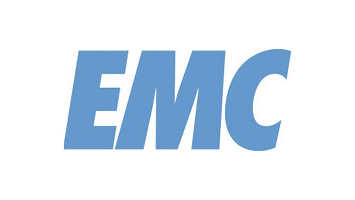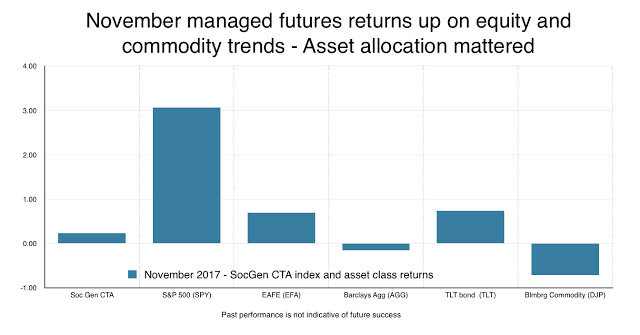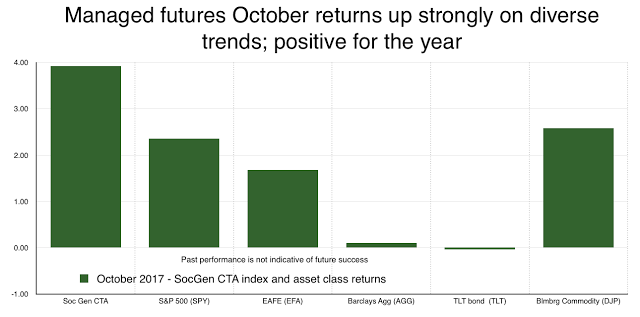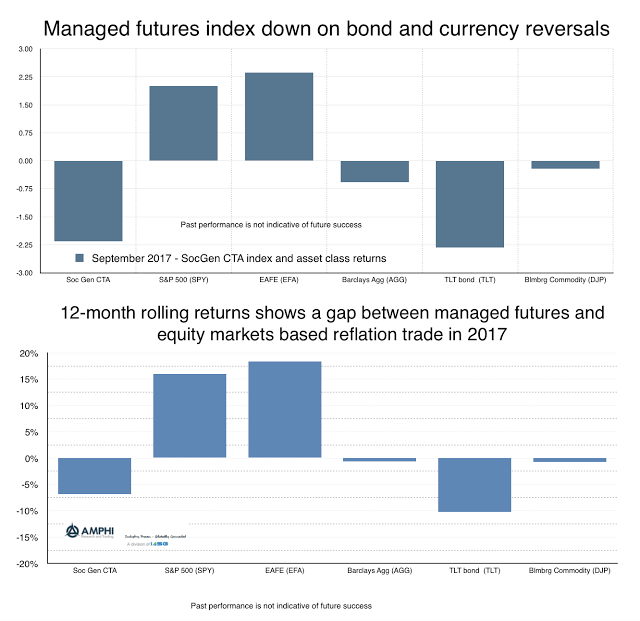Category: Managed Futures

AMPHI Research & Trading’s Systematic Global Macro 2018 Conference Call
IASG Inc. in collaboration with AMPHI Research & Trading will have a discussion with EMC Capital Advisor’s President John Krautsack Thursday January 18th at 11:00 AM EST. Hear about the EMC Alpha Plus Program’s unique portfolio construction, model design and why it has built a three-year track record of superior risk-adjusted returns versus other global macro […]

Managed Futures Up for Month and Positive for the Year Even in a Risk-On World
Much has been made about the value of managed futures during periods of market crisis, but there are also some other regularities that have been found for this strategy that can help with understanding performance.
Slicing the Pie for Better Allocations Using Managed Futures
At the end of the year, investors will review their asset allocation decisions. Often investors will think about their pie chart exposures to different asset classes and strategies. Too often the focus is on asset class allocations and not enough on strategy differences. The problem with asset classes is that correlations may change significantly in a crisis with the usual problem being a movement to one. Diversification is not present when you need it.

Managed Futures is not Trend-Following but it is Close – Broadening the Product Spectrum has Added Strategy Complexity
I would not be the first person to engage in the lazy thinking that managed futures are synonymous with trend-following. For many years, there was little wrong with using both terms to mean the same thing. The majority of managed futures are still trend-following.

Rincon Capital – A Rising Tide Lifts All Boats
John F. Kennedy’s aphorism “a rising tide lifts all boats” seems to be particularly appropriate when describing the results of both the domestic and international equity markets these past 30 days.
Corporate bonds and Managed Futures – A Winning Diversification Combination
Managed futures may not generate crisis alpha if there is no crisis, a sustained decline in equities. In addition, managed futures may not provide as strong a cushion diversification effect during normal times since the correlation between equities and managed futures is slightly positive, and there is no managed futures yield. So how can an […]

Managed Futures Slightly Positive in a Choppy Environment – Performance Driven by Asset Class Weights
Managed futures managers were, on average, positive for the month with returns beating commodities and the fixed income Barclay Aggregate index. Managed futures did not beat the strong equity performance but that should not be a surprise given that equity exposure will only be a small portion of the total risk exposure for managers. Most managers will cap the equity exposure within the program, so even if equities are trending higher, performance will lag a long-only index.

Active Cash Management for Managed Futures – A Simple Addition to a Fund’s Return Profile
Managed futures have unique features given that margin is only a small potion of the total investment. This allows for active collateral management in ways that are more impactful from other hedge funds. For most hedge funds that use a prime broker and make long/short equity investments, the focus of collateral management is with reducing the cost of borrowing. For futures, the leverage is not through borrowing but through the ability to increase notional funding based on the level of margin to equity. A good portion of funds given to any CTA is not managed efficiently but rather just held in cash.
Why Now Might Be the Best Time to Invest in Managed Futures
Managed futures have been in a significant drawdown with poor Sharpe ratios over the last two years, albeit October has been a good performance month. Many investors have discussed throwing in the towel and getting out of this hedge fund strategy. New investors have focused on other strategies and not wasted time with CTA’s. A […]

Thoughts of Managed Futures Death Were Premature
Managed futures returns exploded to the upside with index returns showing big gains relative to alternative asset classes. The positive skew for some managers was even more surprising. We saw some October returns as large as 14%. Every major index we track was close to 3% or higher. For example, the October return using the Morningstar managed futures category was positive 3.45 and the year to date return was up 1.85 percent.
Col. Jessup, Managed Futures, and Code Red for Liquidity
As we approach year-end, it is a good time to think about liquidity and exit strategies from current allocations. Many alternative investments are just not liquid when you need it, even if it is a daily fund. Of course, there is a price or cost with liquidity. Investors may exit but at onerous levels; however, those alternatives that focus trading on liquid instruments will have an advantage over complex strategies or funds that focus on asset that have lower liquidity to start with. Searching for liquidity in a market downturn is a losing game.

Back to Basics on Managed Futures with AIMA – Answering the Question for Why This Strategy Should be Held
There are many works on managed futures that explain the basics of this hedge fund strategy, but the characteristics need to be reinforced especially at current times when the strategy is underperforming other hedge fund strategies. The core reason for holding managed futures is that it provides useful diversification. This diversification is not available from other strategies and this diversification will be especially present during ‘bad times” of a equity decline. Don’t forget that those strategies that have more systematic risk will need to generate higher returns. Investors will be paid to hold them. On the flip-side, there will be a “payment” for managed futures which does well in “bad times”.

Managed Futures Turn Negative on the Renewed Interest in the “Reflation Trade”
Managed futures returns across CTA’s were down on average for September based on reversals in currency and bond trends. The weakening dollar and the strong bond returns during the summer made for good performance in July and August, but the combination of renewed interest in the Trump reflation trade and uncertainty concerning the direction of interest rates changed the trend opportunities.